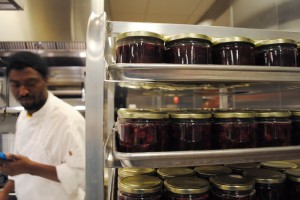
Drexel students under chef Richard Pepino Jr. joined anti-poverty nonprofit Project Oct. 28 at the Free Library of Philadelphia to make and jar “Sister Mary’s Sinfully Delicious Cranberry Sauce.” The team of 11 Drexel students is taking the Center of Hospitality and Sports Management course “Food Preservation,” in which the students learn about jarring and canning techniques, as well as food health and safety skills.
The students worked hard with Project HOME’s social enterprise manager, Scarlett McCahill, and a team of four Project HOME residents to make large amounts of the relish, which they then preserved in jars for sale. By the end of the three-hour work period that evening, they had filled and sealed about 400 jars. On this, Pepino commented, “They’re doing good. They’re doing real good,” despite the hectic chaos which seemed to be dominating the relatively small kitchen space. “It is what it is,” he added.
Jonathan Deutsch, founding director of Drexel’s Center for Hospitality and Sport Management was also present. He explained that this is the third year Project HOME was producing the cranberry relish for the holidays, but that this was the first time Drexel had been involved. McCahill had reached out to both Deutsch and Pepino for assistance and they happily complied.
“[This work is] a way to continue on Drexel’s mission of civic engagement … and also a way to get our students practical experience,” Deutsch said.
He continued, “Here, [the students are] going to work with a ton — an actual ton, not a figurative ton — of cranberries. … Here, we can get that real world experience. [That’s why] it helps for us to partner [with Project HOME], since we can’t do that in our own facilities.”
Chelsey Lowe, the social enterprise and sustainability Philadelphia fellow at HOME, was also in attendance, elbows deep in the relish-making process. She said that all of the cranberries were donated by a distribution center in New Jersey, but that the other ingredients were purchased by HOME. The jars will be sold by HOME vendors as well as online starting Nov. 1, selling at $6.95 a jar. “The residents are really appreciating the [help]. … This is a huge volume and we have more hands,” she said.
The process of making and jarring the relish was detailed and fast-paced. Resident Shonda Brabham said, “When you watch the Food Network channel, and they say go, they really mean go!” She was experiencing this speed first-hand as Pepino controlled the busy kitchen with orders and instructions, hoping to achieve a rate of 100 jars per hour.

First, the jars had to be sanitized and the lids boiled. Then, five pounds of cranberries were mixed with white and brown sugar and about a quarter of a gallon of apple cider. This was boiled until the cranberries were soft and the mixture was thick, then funneled carefully into the prepared jars. Next, the jars were closed tightly and boiled — an essential step to proper jarring technique. Halfway through the night, Pepino proudly brought one of the finished jars over to McCahill, saying that the seal was perfect. An amused and interrupted McCahill just nodded approval, before continuing her discussion with a group of students and residents.
During the event, the team worked in two groups which switched roles halfway through. While one group was busy jarring the relish, the other was having a discussion about HOMElessness in Philadelphia with McCahill. The discussion started with a few statistics on HOMElessness. For example, according to McCahill, research has shown that approximately 9,000 HOMEless people are present in Philadelphia each night — which far exceeds the approximately 4,000 shelter beds available in all of Philadelphia. Also, about one-tenth of the entire HOMEless population actually “appear” as obviously HOMEless to the average passer-by. Finally, non-heterosexual youth are four times more likely to be HOMEless than heterosexual youth.
The discussion then shifted to some simple questions from McCahill: What exactly is HOMElessness? How do we define it as individuals and as a society? What causes HOMElessness? In answer to the first question, she told the group: “HOMElessness [is when] you don’t have a place to stay … that is, you don’t have a safe and dignified place to stay.” The other questions though, she did not answer, instead asking the group to generate responses.
After listing several reasons why HOMElessness occurs, finally the group arrived at the number one cause of HOMElessness, both in Philadelphia, and nationwide: a lack of affordable housing. Finally, McCahill broke the issues of HOMElessness down to the very nitty-gritty and brought a central point to the broad discussion: “This is a major issue. A complex social issue like this one … requires an equally complex response,” she said. The belief and vision behind Project HOME, she added, is that “None of us are HOME until all of us are HOME.” This, essentially, is the project’s mission statement: an effective, coherent and complex response to HOMElessness is the organization’s top priority.
“HOME” stands for affordable Housing, Opportunity through employment, Medical care and Education. Project HOME effectively addresses each of these goals through various programs. It owns over 600 units of affordable housing, where affordable is defined as 30 percent of an area’s median income, and in its 25 years of operation has housed over 9,000 people. HOME also owns and operates five small businesses in which residents are employed and given training for the general workforce. This year alone, 73 HOME residents were employed by the organization itself, and a total of 175 residents found jobs in competitive industries outside of the organization.
HOME also offers medical care in the form of medical, health and psychiatric attention available for all residents. As for education, it runs a K-6 school, multiple after-school teenage outreach groups as well as adult education groups. This year, 43 HOME residents were enrolled in college — a strategically important step for the organization, according to McCahill. Perhaps the most astonishing fact about the organization, in light of these statistics, is the distribution of its funding.
Most nonprofits benefit in the majority from single-source funding, but HOME is funded nearly equally in three parts: private donors, the city and federal government, and the rest from “Low Income Tax Credits.” Most organizations don’t know that nearly one-third of the market cost to build housing meant for low-income owners will be paid for by the government, as long as the organization’s accountant can figure out the paperwork. Luckily, a Drexel alum, now accountant, works for Project HOME and secures these funds. This range of funding makes it possible for HOME to tackle larger projects and initiatives.
The general consensus reached by the students involved in the event was that the opportunity to assist such an inspiring group as Home was unique and incredible. Deutsch said that after tonight, the biggest hope of both Drexel and HOME is that students who were involved will be inspired to come back on their own time to volunteer.
Project HOME has information on getting involved, taking action and donating time or money at

